2024 Core Deposit Intangibles Update
Since Mercer Capital’s most recently published article on core deposit trends in September 2023, deal activity in the banking industry has continued to be rather anemic, but could be showing signs of recovery. Although deal activity has been slow, we have seen a marginal uptick in core deposit intangible values relative to this time last year.
On July 26, 2023, the Federal Reserve increased the target federal funds rate by 25 basis points, capping off a collective increase of 525 basis points since March 2022. Although cuts to the fed funds target rate were anticipated several times over the past year, no changes materialized until the Federal Reserve’s September 2024 meeting. While many factors are pertinent to analyzing a deposit base, a significant driver of value is market interest rates. All else equal, lower market rates lead to lower core deposit values. As shown below, the yield curve for U.S. Treasuries has shifted downward relative to last year at this time, and the market expects further downward movement in short-term rates in the near term.
Figure 1: U.S. Treasury Yield Curve
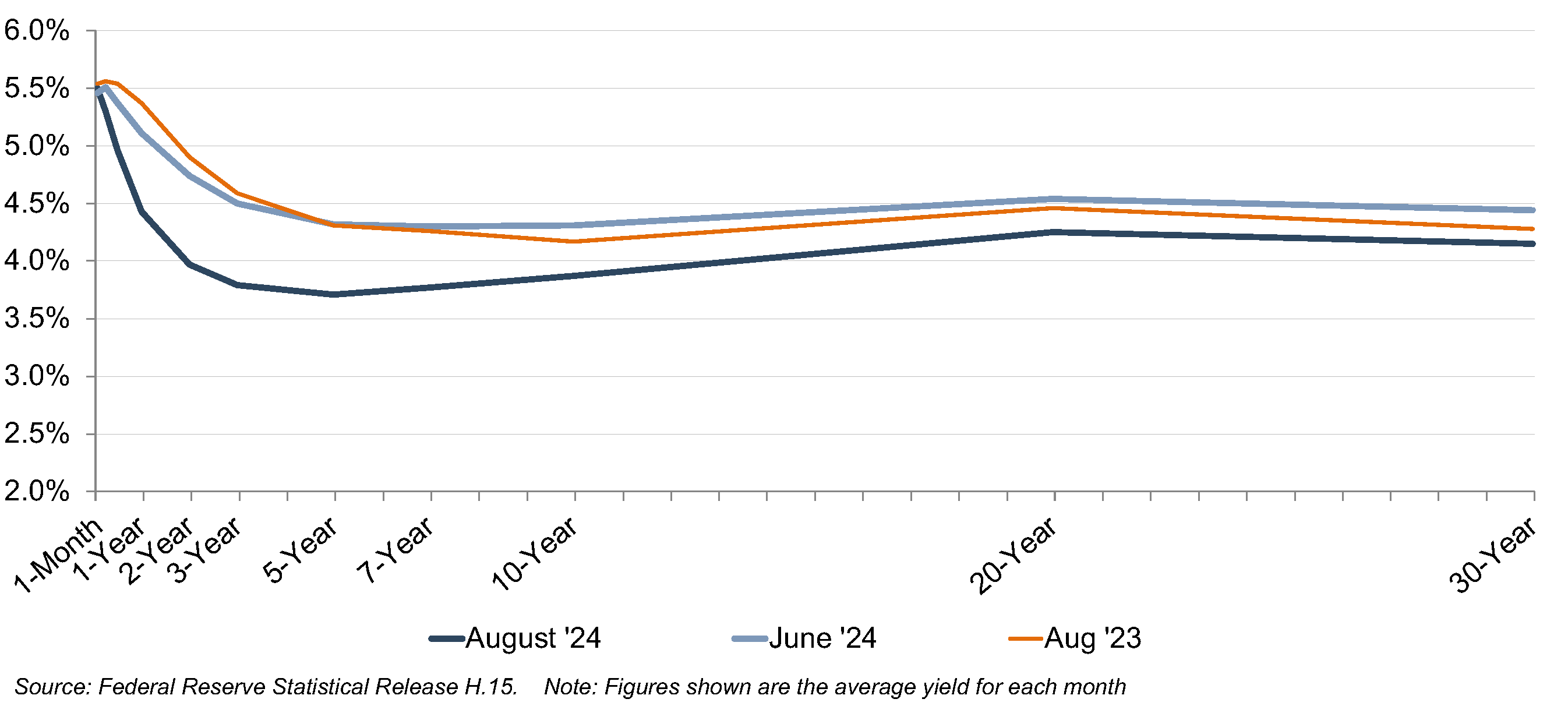
Trends in CDI Values
Using data compiled by S&P Capital IQ Pro, we analyzed trends in core deposit intangible (CDI) assets recorded in whole bank acquisitions completed from 2000 through mid-September 2024. CDI values represent the value of the depository customer relationships obtained in a bank acquisition. CDI values are driven by many factors, including the “stickiness” of a customer base, the types of deposit accounts assumed, the level of noninterest income generated, and the cost of the acquired deposit base compared to alternative sources of funding. For our analysis of industry trends in CDI values, we relied on S&P Capital IQ Pro’s definition of core deposits.1 In analyzing core deposit intangible assets for individual acquisitions, however, a more detailed analysis of the deposit base would consider the relative stability of various account types. In general, CDI assets derive most of their value from lower-cost demand deposit accounts, while often significantly less (if not zero) value is ascribed to more rate-sensitive time deposits and public funds. Non-retail funding sources such as listing service or brokered deposits are excluded from core deposits when determining the value of a CDI.
Figure 2, on the next page, summarizes the trend in CDI values since the start of the 2008 recession, compared with rates on 5-year FHLB advances. Over the post-recession period, CDI values have largely followed the general trend in interest rates—as alternative funding became more costly in 2017 and 2018, CDI values generally ticked up as well, relative to post-recession average levels. Throughout 2019, CDI values exhibited a declining trend in light of yield curve inversion and Fed cuts to the target federal funds rate during the back half of 2019. This trend accelerated in March 2020 when rates were effectively cut to zero.
Figure 2: CDI as % of Acquired Core Deposits
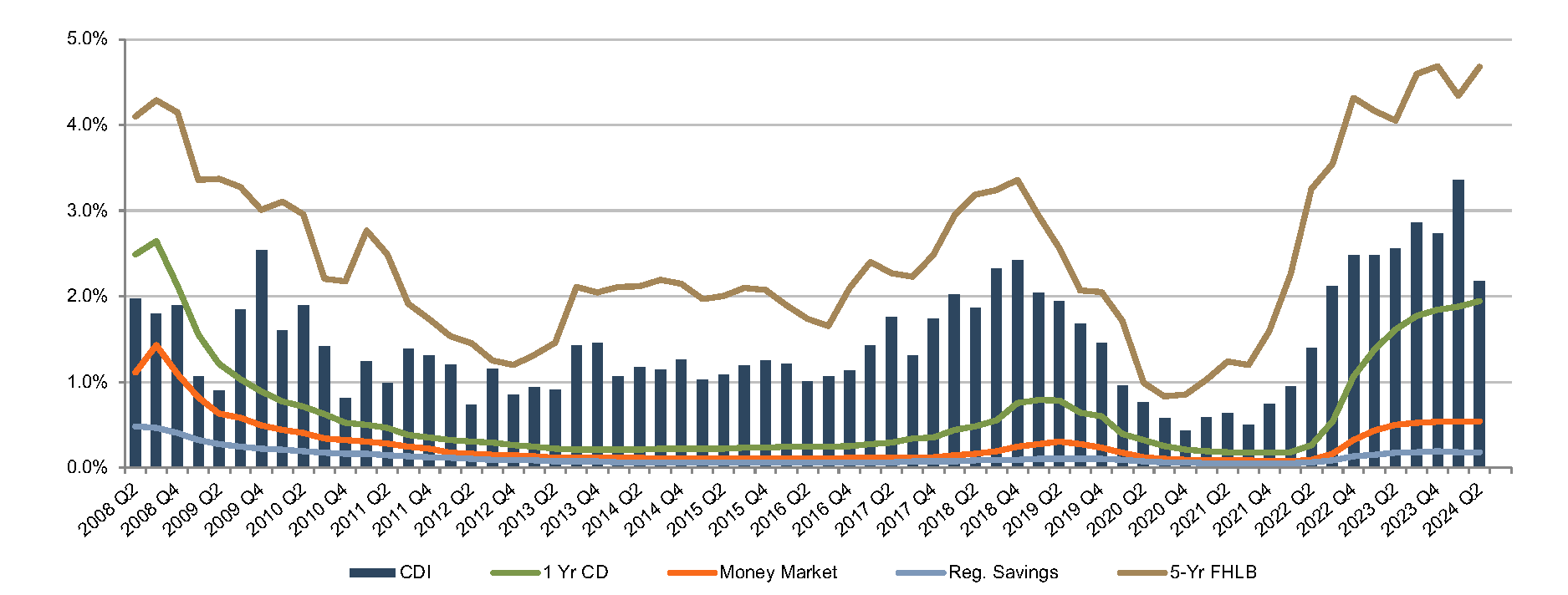
Source: S&P Capital IQ Pro
Click here to expand the image above
CDI values have increased meaningfully in the past few years (averaging 2.74% through mid-September 2024). This compares to 2.58% all of 2023, 1.61% all of 2022 and 0.63% for all of 2021. Recent values are above the post-recession average of 1.47%, and on par with longer-term historical levels which averaged closer to 2.5% to 3.0% in the early 2000s.
As shown in Figure 2, reported CDI values have followed the general trend of the increase in FHLB rates. However, the averages should be taken with a grain of salt. The chart is provided to illustrate the general directional trend in value as opposed to being predictive of specific indications of CDI value due the following factors:
- Last week’s Federal Reserve rate cuts are not reflected in the data above. While the impact on CDI values of one 50 basis point reduction in the fed funds target rate may not be highly material—given that the forward rate curve has anticipated falling short-term interest rates for some time—continued reductions in the fed funds target rate or downward shifts in the yield curve may result in a larger decline in CDI values.
- General market averages do not reflect the individual characteristics of a particular subject’s deposit base.
- Some of the values presented above reflect the estimated core deposit intangible value at deal announcement, rather than the final core deposit intangible value as determined post-closing.
Twenty-three deals were announced in July, August, and the first half of September, and ten of those deals provided either investor presentations or earnings calls containing CDI estimates. Excluding one outlier with a 1.06% estimated CDI value, these CDI estimates ranged from 2.7% to 4.1%. However, the CDI premiums cited in investor presentations can be somewhat difficult to compare, as acquirers may use different definitions of core deposits when calculating the CDI premiums reported to investors. For example, some acquirers may include CDs in the calculation, while other buyers may exclude CDs or include only certain types of CDs.
Generally, we expect CDI values to fall in concert with falling market interest rates. How fast they decline could depend several factors:
- Cost of Funds. Although many believe deposit rates have peaked, a possibility remains that deposit rates will not be as flexible on the way down. For example, notifications of lower rates may trigger some depositors, now accustomed to higher rates, to seek alternatives. Banks may need to weigh their desire to reduce deposit rates against the need to preserve deposit balances. As shown on Figure 3, in falling rate environments, the median cost of funds has tended to decrease at a slower rate than the fed funds target rate. However, interest rate beta is in part determined by the size of the financial institution, as evidenced by Figure 4.
- Deposit Levels. In 2022, total industry deposits fell 1.1%, the largest annual decline on record.2 Last year at this time, less than half of respondents expected deposits to increase at their organization over the next 12 months. However, deposits have been relatively flat since this time last year. In the same survey for the second quarter of 2024, three out of five bankers expect deposits to grow over the next twelve months.3 All else equal, lower deposit runoff assumptions lead to higher indications of CDI value.
Figure 3: Median Cost of Funds as Compared to Target Fed Funds Rate
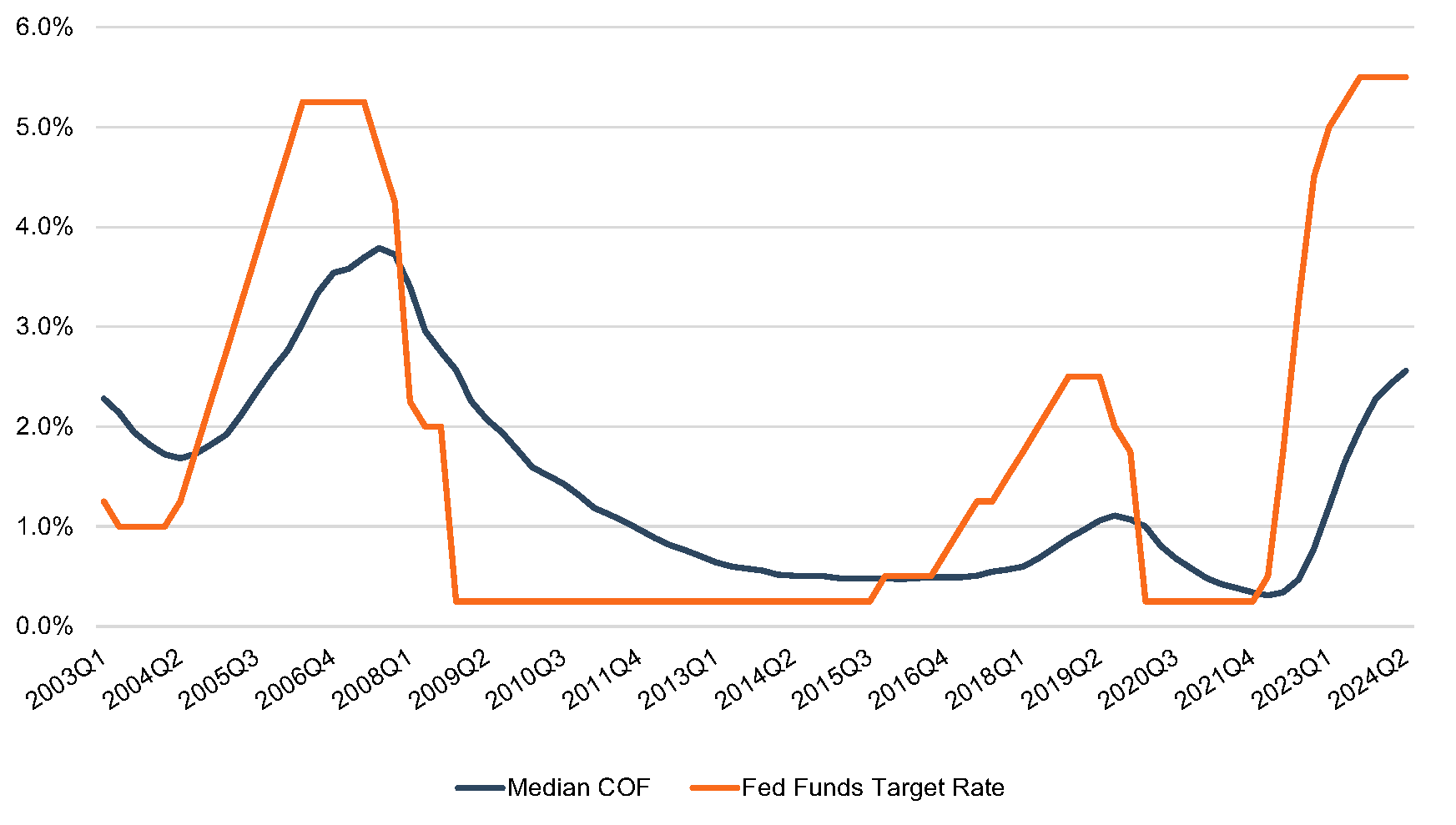
Source: S&P Capital IQ Pro
Figure 4: Cost of Funds by Asset Size – 2Q22 to 2Q24
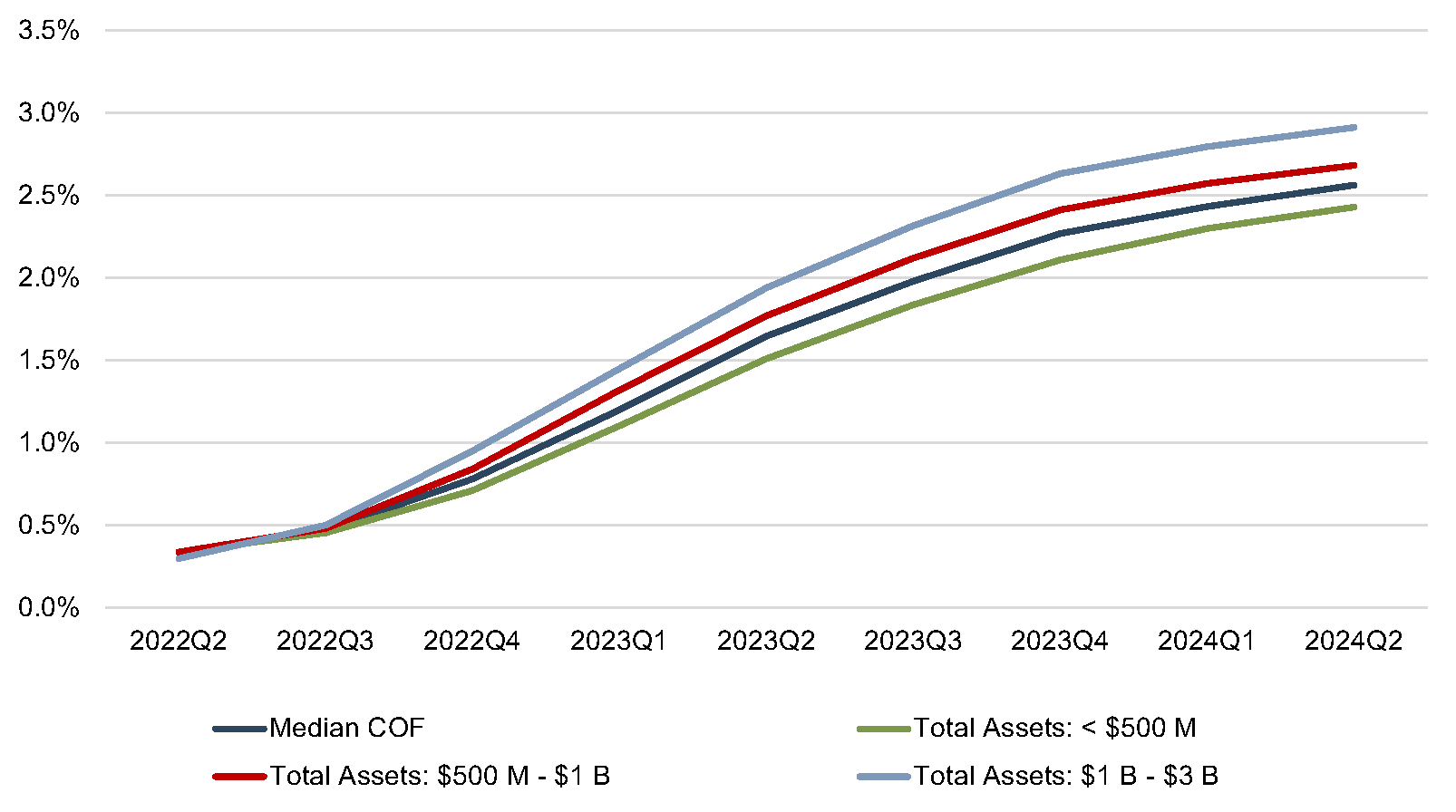 Source: S&P Capital IQ Pro
Source: S&P Capital IQ Pro
Figure 5: Total Industry Deposits Per Federal Reserve H.8 Release
 Source: S&P Capital IQ Pro
Source: S&P Capital IQ Pro
- Deposit Mix and Deposit Beta. Over the past decade, nationwide average deposit mix has shifted in favor of noninterest bearing deposits. In 2023 and 2024, this trend began to reverse in a higher interest rate environment. However, the deposit mix shift toward interest bearing deposits might not continue in a falling interest rate environment. As noninterest-bearing deposits have higher CDI values, this could be a mitigating factor for the anticipated decline in CDI values.
- Uncertain Rate Outlook. At present, the upside risks to inflation have diminished. Should recent positive inflation trends reverse, the Federal Reserve is likely to pause interest rate cuts or even increase rates again. Seven of the FOMC participants expect a further 25 basis point cut in 2024, while nine predict 50 basis points of additional cuts. Two predict no additional cuts, and one predicts a total of 75 basis points of cuts.
Figure 6: Deposit Mix Over Time
 Source: S&P Capital IQ Pro
Source: S&P Capital IQ Pro
- Other Factors. More details within the deposit trial balance tend to provide more meaningful indications of depositor value – and this is especially important to consider on the front end of a deal. When possible, we like to see a customer relationship identifier, information on industry concentrations, more granular detail on account types, several years of deposit history, demographic details surrounding customer age and location, and average account balances over time.
Admittedly, this level of detail is not always feasible due to data limitations, but more detail contributes to a more comprehensive “story” of the deposit base. Before you can value the core deposit intangible asset, you need to begin by ascertaining which accounts and balances are “core”. Furthermore, sometimes a particular relationship might be core, but some or most of its balances at a particular point in time might not be.
Trends In Deposit Premiums Relative To CDI Asset Values
Core deposit intangible assets are related to, but not identical to, deposit premiums paid in acquisitions. While CDI assets are an intangible asset recorded in acquisitions to capture the value of the customer relationships the deposits represent, deposit premiums paid are a function of the purchase price of an acquisition. Deposit premiums in whole bank acquisitions are computed based on the excess of the purchase price over the target’s tangible book value, as a percentage of the core deposit base.
While deposit premiums often capture the value to the acquirer of assuming the established funding source of the core deposit base (that is, the value of the deposit franchise), the purchase price also reflects factors unrelated to the deposit base, such as the quality of the acquired loan portfolio, unique synergy opportunities anticipated by the acquirer, etc. As shown in Figure 7, deposit premiums paid in whole bank acquisitions have shown more volatility than CDI values. Deposit premiums were in the range of 6% to 10% from 2015 to 2022, although this remained well below the pre-Great Recession levels when premiums for whole bank acquisitions averaged closer to 20%. Net interest margin pressure—caused by assets originated at low rates during the pandemic and deposits that proved more rate sensitive than expected—resulted in deposit premiums in 2024 falling to levels last seen in the Great Financial Crisis.
Additional factors may influence the purchase price to an extent that the calculated deposit premium doesn’t necessarily bear a strong relationship to the value of the core deposit base to the acquirer. This influence is often less relevant in branch transactions where the deposit base is the primary driver of the transaction and the relationship between the purchase price and the deposit base is more direct. Figure 8 presents deposit premiums paid in whole bank acquisitions as compared to premiums paid in branch transactions.
Deposit premiums paid in branch transactions have generally been less volatile than tangible book value premiums paid in whole bank acquisitions. Only two branch transactions with reported premium data have occurred year-to-date in 2024. For those transactions, the deposit premiums were 7.5% and 4.0%. The lack of branch transactions, though, is indictive of their value. With high short-term funding costs and tight liquidity, few banks have been willing to part with stable, low-cost core deposits.
Figure 7: CDI Recorded vs. Deposit Premium
 Source: S&P Capital IQ Pro
Source: S&P Capital IQ Pro
Figure 8: Average Deposit Premiums Paid
 Source: S&P Capital IQ Pro
Source: S&P Capital IQ Pro
Accounting For CDI Assets
Based on the data for acquisitions for which core deposit intangible detail was reported, a majority of banks selected a ten-year amortization term for the CDI values booked. Less than 10% of transactions for which data was available selected amortization terms longer than ten years. Amortization methods were somewhat more varied, but an accelerated amortization method, including the sum-of-the-years digits method, was selected in approximately two-thirds of these transactions.
For more information about Mercer Capital’s core deposit valuation services, please contact a member of our Depository Institutions team.
Figure 9: Selected Amortization Term (Years)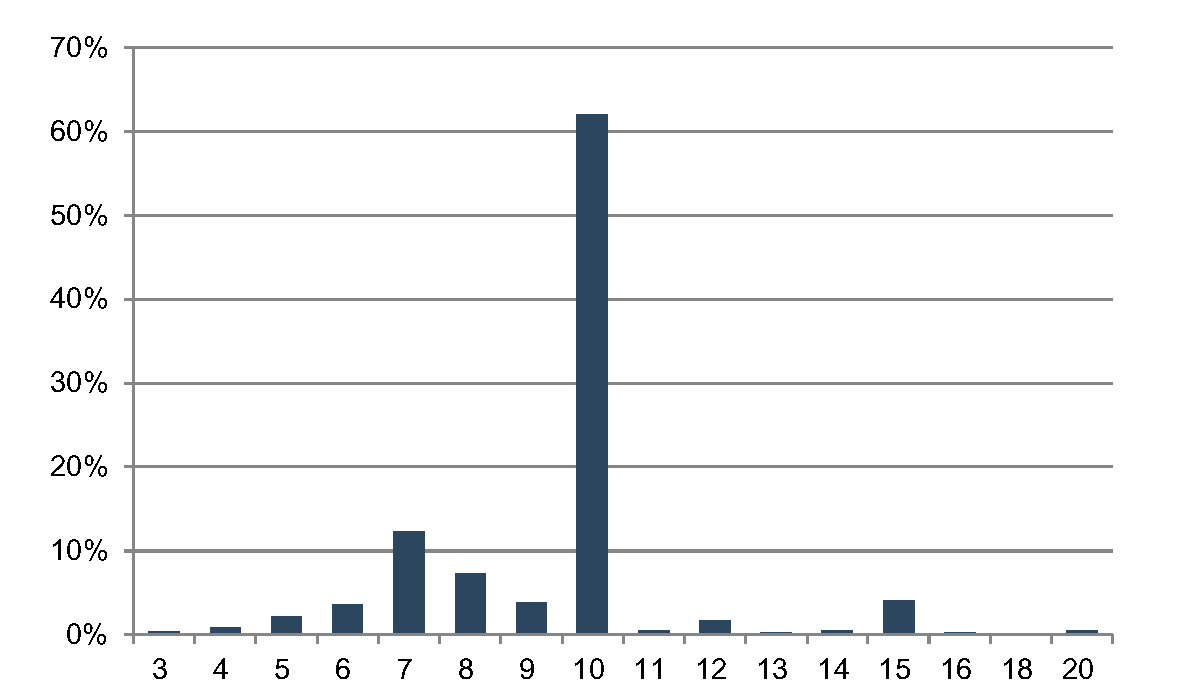
Source: S&P Capital IQ Pro
Figure 10: Selected Amortization Method
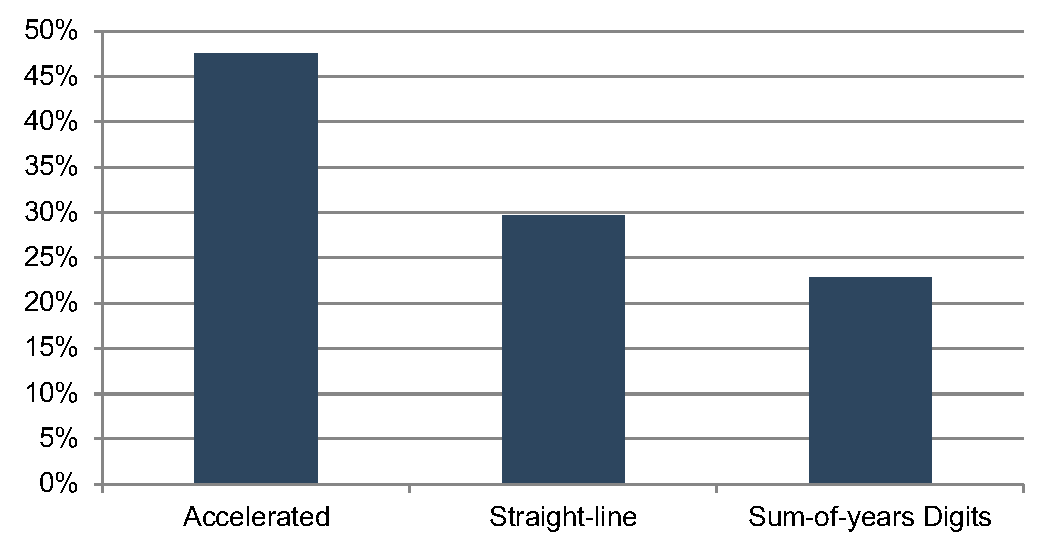 Source: S&P Capital IQ Pro
Source: S&P Capital IQ Pro




